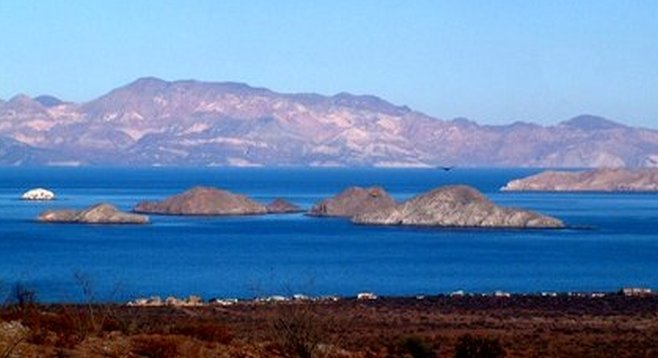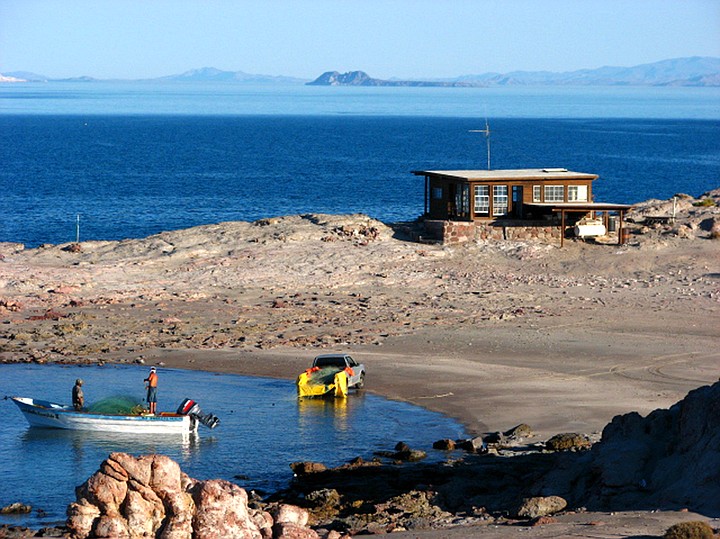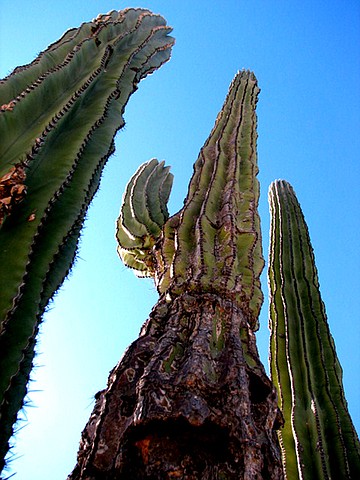 Facebook
Facebook
 X
X
 Instagram
Instagram
 TikTok
TikTok
 Youtube
Youtube

The eastern coastline of northern Baja California is situated on the Sea of Cortez, and supports an entirely different type of habitat and marine life profile than does the Pacific side. Volcanic outcroppings and occasional groups of small, rugged islands intermittently interrupt the miles of warm, sandy beach that adjoin this tepid desert sea.

South of San Felipe, the narrow highway heading toward Puertecitos, 50 miles away, runs parallel to long stretches of unpopulated beach that are a kayak angler’s dream. Catches of orange mouth corvina are not uncommon here during summer. Puertecitos offers a small launch ramp and limited facilities. In spite of being so close to the rapidly growing tourist town just to the north, this area along Baja’s Cortez coast is truly rural in almost every sense of the word.
Don’t expect to find a fancy hotel, a gourmet restaurant or a vast array of amenities for the tourist here; one of the most beguiling land-based features around Puertecitos is the proliferation of small, volcanic hot springs that flow nearby. Out on the water, however, it is a different matter.
The Islas Encantadas, or Enchanted Islands, are just offshore and because of the generally good fishing to be had there, they are usually one of the first stopping points for panga festooned mothership operations that are based in San Felipe.
In addition to solid bottom fishing for leopard grouper, spotted bay bass and cabrilla, the area around the islands is a prime place to catch large white sea bass and yellowtail between June and September.
The dusty, uneven thoroughfare south of Puertecitos has a longstanding reputation as one of the most rutted roads in northern Baja. It can be very intimidating, and probably should not be undertaken except by the most seasoned of Baja travelers. That said, the secluded areas of Bahía Willard and Bahía Gonzaga several miles down the coast are not only breathtakingly beautiful, but also offer great onshore, inshore, and offshore angling opportunities throughout the entire summer. This entire section of coastline features a wealth of open, sandy beaches and rocky coves that are guaranteed to tempt the wandering beachcomber.

Bahía de Los Angeles is a very popular fishing location that lies even further south, but is best reached by automobile via the Transpeninsular Highway. As is true along the entire Cortez coast, summer visitors should expect extremely warm daytime temperatures and plenty of sunshine. The nearby islands attract large schools of baitfish as well as big white sea bass, yellowtail, skipjack, grouper, and cabrilla.

The region is also home to the world’s largest cactus, the giant cardón, which can reach a height of over 60 feet. The first time I ever saw one of these huge cacti, I mistakenly referred to it as a saguaro. This is a common mix-up, since it greatly resembles a smaller, related species that is common in the deserts of Arizona. Some Native Americans believed that the cardón cactus could even take on the attributes of human beings, and actually meander around the moonlit desert while they slept at night.
There are a number of other specimens dotting this arid landscape, such as the notorious and occasionally painful cholla, also known as “jumping cactus.” Also present are a plethora of barrel cacti, pitahaya, and nopal, which produces bright red fruit rich in precious moisture.
The roots, leaves, seeds, and fruits of many of these native plants provided a valuable source of food and water for the indigenous people, who survived for thousands of years in this harsh ecosystem before the first Europeans ever set foot here. Young, tender nopal leaves, pitahaya, and cactus fruit referred to as tunas are still relished by many in northern Baja California today.
But one thing is certain; however you get there, wherever you go, there is a special magic that exists in this section of Baja Norte’s eastern desert region that consistently manages to enchant visitors, many of whom never suspected that they might eventually fall under its spell.
READ MORE ABOUT BAJA: countrymanpress.com/titles/HookedBaja.html


The eastern coastline of northern Baja California is situated on the Sea of Cortez, and supports an entirely different type of habitat and marine life profile than does the Pacific side. Volcanic outcroppings and occasional groups of small, rugged islands intermittently interrupt the miles of warm, sandy beach that adjoin this tepid desert sea.

South of San Felipe, the narrow highway heading toward Puertecitos, 50 miles away, runs parallel to long stretches of unpopulated beach that are a kayak angler’s dream. Catches of orange mouth corvina are not uncommon here during summer. Puertecitos offers a small launch ramp and limited facilities. In spite of being so close to the rapidly growing tourist town just to the north, this area along Baja’s Cortez coast is truly rural in almost every sense of the word.
Don’t expect to find a fancy hotel, a gourmet restaurant or a vast array of amenities for the tourist here; one of the most beguiling land-based features around Puertecitos is the proliferation of small, volcanic hot springs that flow nearby. Out on the water, however, it is a different matter.
The Islas Encantadas, or Enchanted Islands, are just offshore and because of the generally good fishing to be had there, they are usually one of the first stopping points for panga festooned mothership operations that are based in San Felipe.
In addition to solid bottom fishing for leopard grouper, spotted bay bass and cabrilla, the area around the islands is a prime place to catch large white sea bass and yellowtail between June and September.
The dusty, uneven thoroughfare south of Puertecitos has a longstanding reputation as one of the most rutted roads in northern Baja. It can be very intimidating, and probably should not be undertaken except by the most seasoned of Baja travelers. That said, the secluded areas of Bahía Willard and Bahía Gonzaga several miles down the coast are not only breathtakingly beautiful, but also offer great onshore, inshore, and offshore angling opportunities throughout the entire summer. This entire section of coastline features a wealth of open, sandy beaches and rocky coves that are guaranteed to tempt the wandering beachcomber.

Bahía de Los Angeles is a very popular fishing location that lies even further south, but is best reached by automobile via the Transpeninsular Highway. As is true along the entire Cortez coast, summer visitors should expect extremely warm daytime temperatures and plenty of sunshine. The nearby islands attract large schools of baitfish as well as big white sea bass, yellowtail, skipjack, grouper, and cabrilla.

The region is also home to the world’s largest cactus, the giant cardón, which can reach a height of over 60 feet. The first time I ever saw one of these huge cacti, I mistakenly referred to it as a saguaro. This is a common mix-up, since it greatly resembles a smaller, related species that is common in the deserts of Arizona. Some Native Americans believed that the cardón cactus could even take on the attributes of human beings, and actually meander around the moonlit desert while they slept at night.
There are a number of other specimens dotting this arid landscape, such as the notorious and occasionally painful cholla, also known as “jumping cactus.” Also present are a plethora of barrel cacti, pitahaya, and nopal, which produces bright red fruit rich in precious moisture.
The roots, leaves, seeds, and fruits of many of these native plants provided a valuable source of food and water for the indigenous people, who survived for thousands of years in this harsh ecosystem before the first Europeans ever set foot here. Young, tender nopal leaves, pitahaya, and cactus fruit referred to as tunas are still relished by many in northern Baja California today.
But one thing is certain; however you get there, wherever you go, there is a special magic that exists in this section of Baja Norte’s eastern desert region that consistently manages to enchant visitors, many of whom never suspected that they might eventually fall under its spell.
READ MORE ABOUT BAJA: countrymanpress.com/titles/HookedBaja.html
Comments